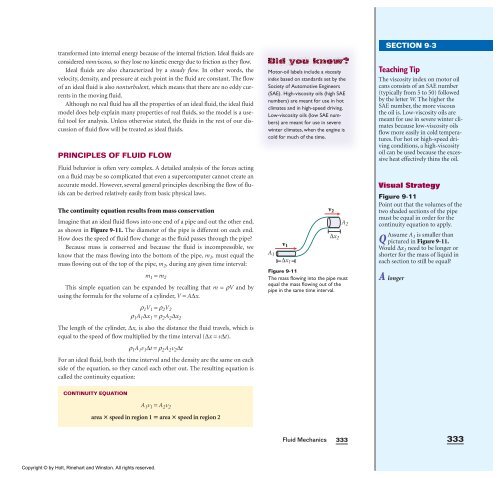You also want an ePaper? Increase the reach of your titles
YUMPU automatically turns print PDFs into web optimized ePapers that Google loves.
transformed into internal energy because of the internal friction. Ideal fluids are<br />
considered nonviscous, so they lose no kinetic energy due to friction as they flow.<br />
Ideal fluids are also characterized by a steady flow. In other words, the<br />
velocity, density, and pressure at each point in the fluid are constant. The flow<br />
of an ideal fluid is also nonturbulent, which means that there are no eddy currents<br />
in the moving fluid.<br />
Although no real fluid has all the properties of an ideal fluid, the ideal fluid<br />
model does help explain many properties of real fluids, so the model is a useful<br />
tool for analysis. Unless otherwise stated, the fluids in the rest of our discussion<br />
of fluid flow will be treated as ideal fluids.<br />
PRINCIPLES OF FLUID FLOW<br />
<strong>Fluid</strong> behavior is often very complex. A detailed analysis of the forces acting<br />
on a fluid may be so complicated that even a supercomputer cannot create an<br />
accurate model. However, several general principles describing the flow of fluids<br />
can be derived relatively easily from basic physical laws.<br />
The continuity equation results from mass conservation<br />
Imagine that an ideal fluid flows into one end of a pipe and out the other end,<br />
as shown in Figure 9-11. The diameter of the pipe is different on each end.<br />
How does the speed of fluid flow change as the fluid passes through the pipe?<br />
Because mass is conserved and because the fluid is incompressible, we<br />
know that the mass flowing into the bottom of the pipe, m 1, must equal the<br />
mass flowing out of the top of the pipe, m 2, during any given time interval:<br />
m1 = m2 This simple equation can be expanded by recalling that m = rV and by<br />
using the formula for the volume of a cylinder, V = A∆x.<br />
r1V1 = r2V2 r1A1∆x1 = r2A2∆x2 The length of the cylinder, ∆x, is also the distance the fluid travels, which is<br />
equal to the speed of flow multiplied by the time interval (∆x = v∆t).<br />
r 1A 1v 1∆t = r 2A 2v 2∆t<br />
For an ideal fluid, both the time interval and the density are the same on each<br />
side of the equation, so they cancel each other out. The resulting equation is<br />
called the continuity equation:<br />
CONTINUITY EQUATION<br />
A 1v 1 = A 2v 2<br />
area speed in region 1 area speed in region 2<br />
Copyright © by Holt, Rinehart and Winston. All rights reserved.<br />
Motor-oil labels include a viscosity<br />
index based on standards set by the<br />
Society of Automotive Engineers<br />
(SAE). High-viscosity oils (high SAE<br />
numbers) are meant for use in hot<br />
climates and in high-speed driving.<br />
Low-viscosity oils (low SAE numbers)<br />
are meant for use in severe<br />
winter climates, when the engine is<br />
cold for much of the time.<br />
A1<br />
v1<br />
∆x1<br />
<strong>Fluid</strong> <strong>Mechanics</strong><br />
v2<br />
∆x2<br />
A2<br />
Figure 9-11<br />
The mass flowing into the pipe must<br />
equal the mass flowing out of the<br />
pipe in the same time interval.<br />
333<br />
SECTION 9-3<br />
Teaching Tip<br />
The viscosity index on motor oil<br />
cans consists of an SAE number<br />
(typically from 5 to 50) followed<br />
by the letter W. The higher the<br />
SAE number, the more viscous<br />
the oil is. Low-viscosity oils are<br />
meant for use in severe winter climates<br />
because low-viscosity oils<br />
flow more easily in cold temperatures.<br />
For hot or high-speed driving<br />
conditions, a high-viscosity<br />
oil can be used because the excessive<br />
heat effectively thins the oil.<br />
Visual Strategy<br />
Figure 9-11<br />
Point out that the volumes of the<br />
two shaded sections of the pipe<br />
must be equal in order for the<br />
continuity equation to apply.<br />
Assume A1 is smaller than<br />
Q pictured in Figure 9-11.<br />
Would ∆x1 need to be longer or<br />
shorter for the mass of liquid in<br />
each section to still be equal?<br />
A<br />
longer<br />
333
















